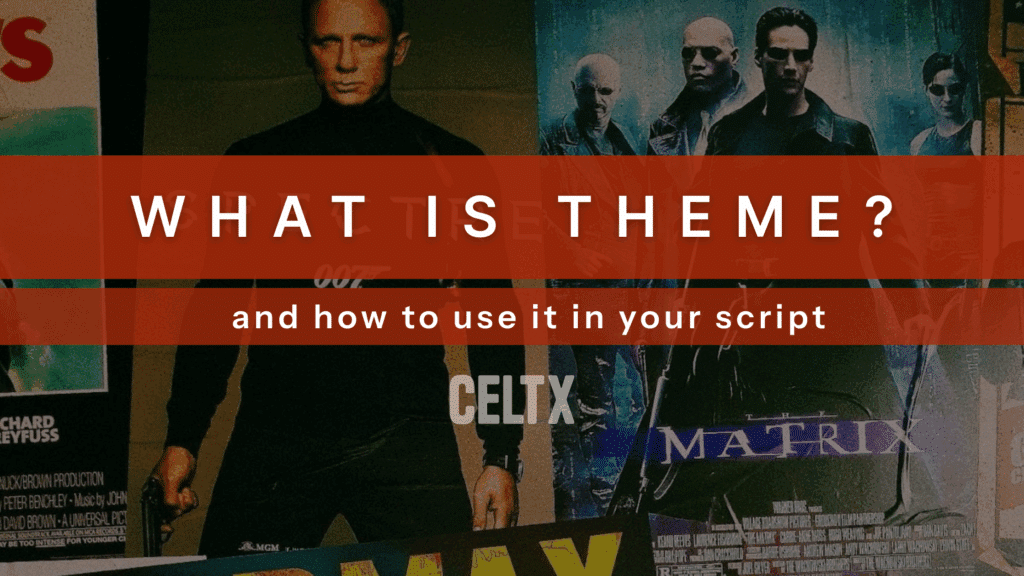
Metaphor. It’s one of the most powerful storytelling tools available to us as screenwriters. On the surface, plot, dialogue, and character arcs are there to move a script forward. But metaphor works on a deeper level, creating resonance for your audience. They may not realize the metaphor is there, but they can certainly feel it.
A well-placed metaphor can elevate a screenplay from competent to unforgettable! But what exactly is a metaphor? How does it differ from other literary devices? And how can you use it in your own screenplay?
Well, the answer to all those questions and more are coming up in today’s blog!
So, without further ado…
Table of Contents
- What is a Metaphor?
- Difference Between Metaphor, Simile, and Symbolism
- How Metaphors Enhance Storytelling in Screenplays
- Examples of Effective Metaphors in Film and TV
- Metaphor Generator
- How to Apply Metaphor in Your Own Script
- FAQs
- Conclusion
What is a Metaphor?
Firstly, what does a metaphor mean?
A metaphor is a way of understanding one thing in terms of another. Instead of saying something directly, a metaphor draws comparison between two unrelated things to reveal a deeper truth.
Okay, let’s look at an example. In storytelling, a storm might not just be weather; it can embody the chaos within a character’s mind. Like how a house on fire might symbolize a crumbling marriage. Metaphors allow us to communicate layered meaning with imagery, giving scenes more weight and texture.
In other words, a metaphor is meaning in disguise, allowing us to connect the seen with the unseen and the literal with the abstract. And when we embed it into our stories, we give our audiences the chance to participate in interpretation, which makes their experience even more engaging.

Metaphor is also universal. Every culture has metaphors woven into its language, myths, and storytelling traditions. Audiences may come from different backgrounds, but metaphors can bridge those divides and tap into the shared human experience. Take fear, love, ambition and regret: they’re images that everyone can relate to.
Difference Between Metaphor, Simile, and Symbolism
Okay, so understandably, it’s really easy to confuse metaphor with other literary devices. However, it’s important to differentiate them and clearly define their distinct functions in order to use them properly in our writing.
Let’s take a look at each:
Metaphor
Our old friend and implicit comparison. For example, “He’s a ticking time bomb.” There’s no ‘like’ or ‘as.’ Instead, the subject becomes the other thing, creating immediacy and boldness.
Simile
This is an explicit comparison, using ‘like’ or ‘as’. So, something like, “He’s like a ticking time bomb.” Less subtle, often more direct. Similes are useful when you want clarity but still add poetic flair.
Symbolism
An object, person, or element that consistently represents something beyond itself. Such as a red rose symbolizing love, a broken mirror symbolizing fractured identity. Symbols may function as metaphors but don’t always carry the same directness.
Okay, so let’s summarize:
- Metaphor is a statement
- Simile is a comparison
- Symbolism is representation
Yes, all three can overlap, but understanding the distinction help us use each deliberately in our screenplays.
How Metaphors Enhance Storytelling in Screenplays
Metaphors in screenwriting enrich scripts by layering additional meaning onto scenes, characters and dialogue. How?
Well, let’s dive in!
Thematic Resonance
Firstly, metaphors reinforce your story’s key themes. In The Shawshank Redemption, the rock hammer isn’t just a tool. It symbolizes patience, persistence, and eventual freedom. The tunnel Andy digs is as much metaphorical as it is physical.

Emotional Depth
Metaphors also allow audiences to feel more that what’s on the surface. A character trapped in a small apartment might reflect their feeling of emotional entrapment. When audiences see this, they don’t just understand the character’s feelings but empathize with them.
Visual Power
Remember, screenwriting is a visual medium! Metaphors let you ‘show, not tell’. A wilting plant can communicate a relationship’s decline without a single word. A broken clock on the wall can silently hint at a character’s inability to move past a traumatic event.
Memorable Moments
Metaphors stick in people’s minds. Audiences may forget dialogue, but they’ll remember powerful visual metaphors long after the credits roll. Think the spinning top in Inception. Whether it falls or not is less important than what it represents: reality vs. illusion.

Efficiency of Expression
Last but not least, metaphor can condense complex emotional or thematic material into a single striking image. This efficiency is worth its weight in gold when it comes to screenwriting. Brevity and impact matter!
DID YOU KNOW? Celtx can help you weave powerful metaphors into your scripts.
Start your free trial today!
Examples of Effective Metaphors in Film and TV
Now we’ve delved into the world of the metaphor, let’s see it in action in some of our favorite movies and TV shows:
American Beauty (1999)
The floating plastic bag symbolizes both beauty and futility, showing how something ordinary can carry extraordinary weight. The metaphor reinforces the film’s central idea: finding meaning and beauty in the mundane.
Jaws (1975)
The shark isn’t just a predator; it’s a metaphor for fear itself. An unstoppable force lurking beneath the surface. The townspeople’s denial of the danger mirrors how societies often ignore looming threats.
The Matrix (1999)
The red pill vs. blue pill is a metaphor for truth vs. ignorance. The entire film functions as a metaphor for breaking free from societal illusions, questioning reality itself.
Breaking Bad (2008-2013)
Walter White’s transformation into Heisenberg isn’t just a character arc, but a metaphor for corrupted ambition, showing how power can poison a person. His blue meth itself also becomes its own metaphor for both perfection and destruction.
Eternal Sunshine of the Spotless Mind (2004)
The collapsing memoryscapes metaphorically represent how fragile and fleeting love and memory truly are. Each scene of Joel losing Clementine is both literal and metaphorical with memories being erased and love unravelling.
The Lion King (1994)
The ‘Circle of Life’ isn’t just a catchy theme but a metaphor for continuity, responsibility, and the balance of nature. Simba’s journey mirrors this metaphor, from his exile to acceptance of his role and return to Pride Rock.
Mad Men (2007-2015)
Don Draper’s constant reinventions are metaphors for the American Dream itself which is alluring and ever-changing. But ultimately, it’s a dream that’s completely hollow if built on lies.
All of these examples highlight how metaphors can define not just individual moments but entire narratives. They elevate the text into something symbolic and emotionally impactful that an audience will remember!
Metaphor Generator
Want to start building metaphors into your own script? Well, here are a few prompts and ideas to get you thinking!
Weather as Emotion
- Rain for sadness, thunderstorms for conflict, sunshine for clarity.
- A sudden change in weather can also mirror emotional shifts within the story.
Objects as Character States
- A cracked phone screen could symbolize a broken sense of self.
- A locked door representing emotional unavailability.
- A tattered coat suggesting long-standing hardship.
Journeys as Growth
- A road trip as self-discovery.
- A climb up a mountain as ambition.
- A sinking ship as inevitable failure.
Even something as simple as a bus ride can become metaphorical when framed right.
Animals as Archetypes
- A caged bird as longing for freedom.
- A wolf as danger or primal instinct.
- A chameleon as someone adapting to survive.
Spaces as Psyche
- A messy room as chaos of the mind.
- An empty house as loneliness.
- A maze as confusion or lack of direction.
- A locked attic as repressed memory.

Now it’s your turn…
Celtx Challenge!
Take one of the following prompts and write a scene around it:
- A candle burning out (metaphor for dwindling hope).
- A bridge collapsing (metaphor for a broken relationship).
- A clock that won’t stop ticking (metaphor for pressure or mortality)
The key is not to just insert metaphors at random but to let them grow organically from your characters and story world.
Once you’ve written your scene, why not share it with us? Find us @celtx_inc on Instagram.
Map out your story’s themes and symbols directly in Celtx. Sign up now!
How to Apply Metaphor in Your Own Script
If you’re finding metaphors a little more complicated than you’d hoped, then never fear! Here are our seven top tips to nailing metaphors in your screenplays.
1. Start with Theme
First, you need to identify your story’s central theme. Is it about freedom, love, ambition, loss? Once you’ve solidified your theme, your metaphor should align with it. For example, if your theme is redemption, think of metaphors that embody cleansing, rebirth, or transformation.
2. Integrate Naturally
Avoid forcing metaphors. They should emerge organically from the story world and work best when it feels inevitable. Take The Great Gatsby where the green light works as a metaphor for hope and unattainable desire precisely because it fits seamlessly into the story’s setting.

3. Make it Visual
Remember, you’re writing for the screen. Choose metaphors that can be communicated visually rather than abstractly. Think of how Parasite uses the semi-basement apartment and stairs to show class hierarchy.

4. Use Subtlety
Not every metaphor has to be grand or obvious. Sometimes the smallest details such as a photograph out of frame or a character refusing to look in a mirror can carry the strongest impact.
5. Don’t Overload
While metaphors are powerful, too many competing ones can completely clutter your script. Choose a few strong ones and consistently develop them. Just like in The Life of Pi, the tiger is enough and doesn’t need any additional metaphors fighting for the audience’s attention.

6. Test Your Metaphor
Ask yourself this: does this metaphor clarify or confuse? A good metaphor enhances understanding, while a weak one distracts or muddles.
7. Develop Over Time
Some of the best metaphors grow as the story progresses. Reconsider the spinning top in Inception, which gains new meaning as the film unfolds.
And for more top tips on screenwriting, click here!
FAQs
A metaphor in storytelling is a way of representing one idea, emotion, or theme through another image, object, or event. It’s a way of saying more than what’s literally shown on screen. Metaphors invite audiences to interpret and feel, not just observe.
They make your story richer, more layered, and more memorable. They add emotional depth and can communicate theme visually, which is crucial for film. A metaphor can turn a scene from functional into unforgettable.
Yes. However, they should always complement, not compete.
Conclusion
Metaphor is a screenwriter’s secret weapon. It deepens character, strengthens theme, and transforms the ordinary into the extraordinary. By learning to spot, generate, and integrate metaphors into your scripts, you give your audience a richer, more resonant experience.
So, the next time you sit down to write, ask yourself: what’s my metaphor? That single question can unlock new layers in your story.
Bring your ideas to life with Celtx Screenwriting Software. Start writing today!
Up Next:

What is Theme — And How to Use It in Your Script
Metaphors often point toward a story’s deeper meaning. Learn how to identify and strengthen your screenplay’s central theme.
